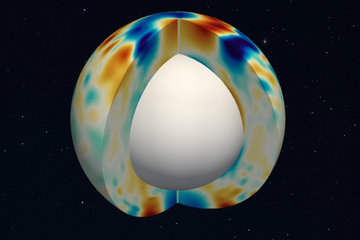All genres
21.
Journal Article
HF-pump-induced parametric instabilities in the auroral E-region. Advances in Space Research 29 (9), pp. 1363 - 1368 (2002)
22.
Journal Article
Excitation of heater-enhanced plasma and ion lines near the reflection level of a hight-frequency pump wave. Journal of Plasma Physics 66 (1 & 2), pp. 71 - 89 (2001)
23.
Journal Article
Time-varying propagation circuits, description and applications. Journal of Atmospheric and Solar-Terrestrial Physics 63, pp. 215 - 220 (2001)
24.
Journal Article
High-latitude ground-based observations of the thermospheric ion-drag time constant. Geophysical Research Letters 28 (7), pp. 1395 - 1398 (2001)
25.
Journal Article
High-resolution maps of the characteristic energy of precipitating auroral particles. Journal Geophysical Research 106 (A12), pp. 28925 - 28937 (2001)
26.
Journal Article
Search for light ion outflow by incoherent scatter radar. Radio Science 36 (6), pp. 1509 - 1521 (2001)
27.
Journal Article
A generation mechanism of the topside enhanced incoherent backscatter during high frequency modification experiments in Tromsø. Geophysical Research Letters 28 (3), pp. 479 - 482 (2001)
28.
Journal Article
Combined EISCAT and Fabry-Perot interferometer measurements of ionospheric-thermospheric coupling. Phys. Chem. Earth (B) 25, pp. 563 - 566 (2000)
29.
Journal Article
(B) - Direct calculation of F-region Joule heating from simultaneous ion and neutral measurements at high latitudes. Phys. Chem. Earth (B) 25 (5-6), pp. 439 - 442 (2000)
30.
Journal Article
Ion-neutral coupling in the high-latitude F-layer from incoherent scatter and Fabry-Perot interferometer measurements. Annales Geophysicae 18 (9), pp. 1145 - 1153 (2000)
31.
Journal Article
A comparison of vertical thermospheric winds from Fabry-Perot interferometer measurements over a 50 km baseline. Advances in Space Research 26, pp. 985 - 988 (2000)
32.
Journal Article
A comparison of thermospheric winds and temperatures from Fabry-Perot interferometer and EISCAT radar measurements with models. Advances in Space Research 26, pp. 979 - 984 (2000)
33.
Journal Article
High-latitude HF-induced airglow displaced equatorwards of the pump beam. Geophysical Research Letters 27 (17), pp. 2817 - 2820 (2000)
34.
Journal Article
HF induced airglow: double patches! Phys. Chem. Earth (B) 25 (5-6), pp. 475 - 481 (2000)
35.
Journal Article
On the electron distribution function in the F region and airglow enhancements during HF modification experiments. Geophysical Research Letters 27 (18), pp. 2857 - 2860 (2000)
36.
Journal Article
Measurements of HF-enhanced plasma and ion lines at EISCAT with high altitude resolution. Journal Geophysical Research 105 (A4), pp. 7429 - 7439 (2000)
37.
Journal Article
The CONSERT instrument for the ROSETTA mission. Advances in Space Research 24, pp. 1115 - 1126 (1999)
38.
Journal Article
Nonlinear structuring of the ionosphere modified by powerful radio waves at low latitudes. Physics Letters A 251, pp. 311 - 321 (1999)
39.
Journal Article
A characterization of a comet nucleus interior: inversion of simulated radio frequency data. Planetary and Space Science 47, pp. 885 - 904 (1999)
40.
Journal Article
A search for the location of the HF excitation of enhanced ion acoustic and Langmuir waves with EISCAT and the Tromsø heater. Radiophys. Quantum Electron. 42 (7), pp. 607 - 618 (1999)











